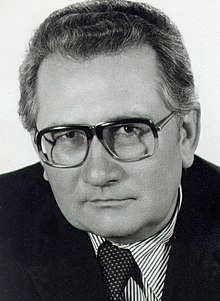Wolf-Dietrich Wittels
Wolf-Dietrich Wittels (born July 19, 1921 in Vienna ; † March 3, 1979 ibid) was an Austrian dermatologist who primarily dealt with the treatment of burns .
Life
Wittels began studying medicine in Vienna in 1939. In 1941 he was drafted into the Wehrmacht . He did military service in the medical department of a tank division on the Eastern Front and in Italy . During this time he was able to gain significant experience in the treatment of frostbite and burns. In 1945 he was seriously wounded himself.
In 1948 he received his doctorate in medicine from the University of Vienna . He became an assistant at the I. University Skin Clinic in Vienna under the clinic directors Leopold Arzt (1883–1955) and Josef Tappeiner (1909–1996).
At the Vienna university clinics, the treatment of burn accidents was traditionally based at the dermatology clinic. This was due to the development of the “water bed” by the clinic director Ferdinand von Hebra (1816–1880). Wittels worked intensively on modernizing the treatment of burns, headed the “waterbed ward” and developed homologous and heterologous skin transplantation from its clinical beginnings into a routine method.
He completed his habilitation in 1962 on the possibilities of large-scale skin replacement from a clinical and experimental point of view . In this work he described for the first time in medical literature the use of split-thickness skin grafts from embryonic calves to cover human skin defects.
He was subsequently appointed deputy head of the clinic and university professor. In 1975 he was appointed head of the department for the treatment of burns at the 1st University Dermatology Clinic. He started planning the first Austrian intensive burn unit for the new General Hospital (AKH) in the city of Vienna . In 1979 he died of a late complication of his war injury.
Works (selection)
- Antibiotics and corticosteroids in the treatment of burns . In: Wiener Klinische Wochenschrift Vol. 83 (1971), pp. 936-938 (article in German language).
- Burns and their treatment . In: Journal for skin and sexually transmitted diseases, volume 46 (1971), pp. 761–766 (article in German language).
- Homologous and heterologous skin transplantation in extensive burns . In: Panminerva medica 11th vol. (1969), pp. 57-58.
- Possibilities of extensive skin replacement from a clinical and experimental point of view . In: Journal of Clinical Medicine, 17th vol. (1962), Issue 9, pp. 535-575 ( habilitation thesis ).
- On the biological and clinical behavior of homologus and heterologus skin transplants . In: Wiener Klinische Wochenschrift Vol. 75 (1963), pp. 301-303.
- The theoretical and clinical significance of the homoid grafting of human skin . In: Archive for Clinical and Experimental Dermatology, Vol. 206 (1957), pp. 718–723.
- About the possibilities and limits of skin grafting for the most severe burns . In: Archive for Clinical and Experimental Dermatology Vol. 211 (1960), pp. 343–347.
Web links
- Entry about Wolf-Dietrich Wittels in P. Altmeyer: Encyclopedia of Dermatology
| personal data | |
|---|---|
| SURNAME | Wittels, Wolf-Dietrich |
| BRIEF DESCRIPTION | Austrian dermatologist |
| DATE OF BIRTH | July 19, 1921 |
| PLACE OF BIRTH | Vienna , Austria |
| DATE OF DEATH | March 3, 1979 |
| Place of death | Vienna , Austria |
